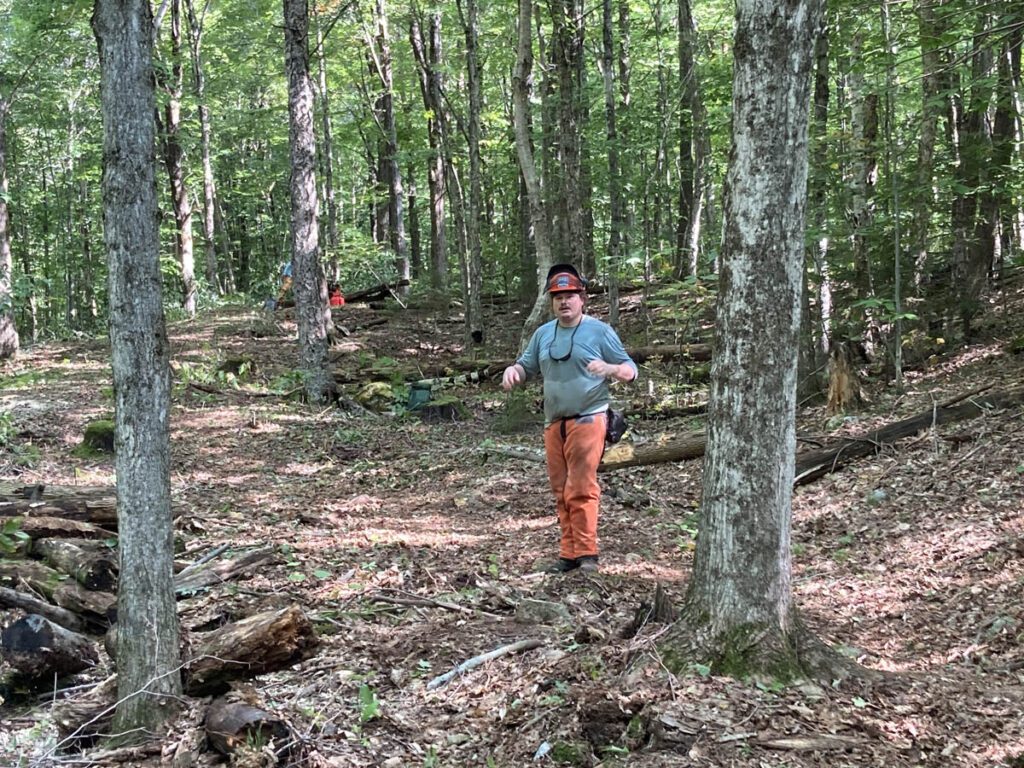
It’s Friday afternoon in late August, but the workday is still in full swing for the Vermont Youth Conservation Corp (VYCC) crew at Vermont Family Forests’ Abrahams Knees property in Lincoln. VYCC crew leader Hank shuts off his chainsaw and calls out, “Hot!”
That’s the signal that the tree he’s been prepping is ready to fall. Because he has used the Game of Logging felling technique, which maximizes safety and precise directional felling, the tree is still standing in place, but is ready to fall with just a small cut to a “trigger” of wood that’s holding the tree in place.
The VYCC crew members in the area—Kelvin, Sam, Sarah, and Alex—watch from a safe distance as Hank restarts his saw, touches it to the trigger and steps away as the tree slowly shifts, leans, and drops away from him to the forest floor with a reverberating thump.

“Clear!” At Hank’s call, crew members return to their work cutting and dragging brush and rolling logs off the trail.
This is the third year Vermont Family Forests has hosted a VYCC crew for a week of forest work, but the first time we’ve hired a crew trained in chainsaw use. In 2021 and 2022, VYCC crews used hand tools and muscle power to help us restore and rewild roadways on VFF’s Abraham’s Knees and Cold Brook parcels to help reduce erosion.
In 2023, Vermont Family Forests hired Atkins Excavating to install deep erosion control structures on the steepest sections of the old access road at Abraham’s Knees, some of which exceeded 40% slope. With this completed, we requested a VYCC chainsaw crew for the 2024 field season to help cut a new, gently sloping access path—what VFF Executive Director David Brynn calls a line of grace.
With a 7% average grade, this line of grace meanders up the steep mountain slopes. In preparation for the crew’s arrival, we flagged the centerline of the trail and marked with paint the trees we wanted them to fell to create a 16-foot-wide path.

When the VYCC crew arrived to start the project Monday morning, David Brynn introduced them to the land, to VFF’s approach to interacting with the land, and to the specifics of how he wanted them to carry out the project. He pointed out blue flags along the path, which indicate where broad-based dips will be excavated next year. These erosion-control structures will direct stormwater off the pathway and back into the forest. David explained why dips are a much better erosion solution than culverts, which are costly, prone to becoming clogged and blowing out during big storms, and require roadside ditching that concentrates stormflow.
David asked the crew to avoid placing brush in and around these flagged broad-based dip sites, so as not to obstruct the future dip excavation work. In between dip sites, they should drag all lopped wood and branches to the down-slope side of the path and lay the brush about four feet from the path edge. When the access path is built next year, this woody barrier will naturally catch any debris shed from the pathway.
David instructed the crew to cut all stumps as flush with the ground as possible. Though some stumps will need to be removed when the access path is built, most will be left in place in the pathway, so that they act as a fibrous mat–-a natural landscape fabric. David explained that excavating the path only where needed minimizes both site disturbance and project cost. This method of building lines of grace from dip to dip, he noted, is a tried-and-true method of constructing forest access without culverts.
Crew members loved the work. For VYCC Forest Project Manager Bill Anderson, the project was a glove-fit for giving crew members experience in effective trail clearing practices—so much so that he brought in a second crew mid-week to work on the project.
By week’s end the two crews had finished clearing about 2/3 of the new access path. Bill plans to bring a winter forestry crew to Abraham’s Knees in November, where they can learn and practice directional felling while finishing up the trail clearing.
Our aim is to complete the path excavation work next summer, creating a path that will accommodate both foot recreation and log-forwarding equipment.
A big thank you to all the hard-working, skilled VYCC crew members who took part in the project. We look forward to working with VYCC again soon!







